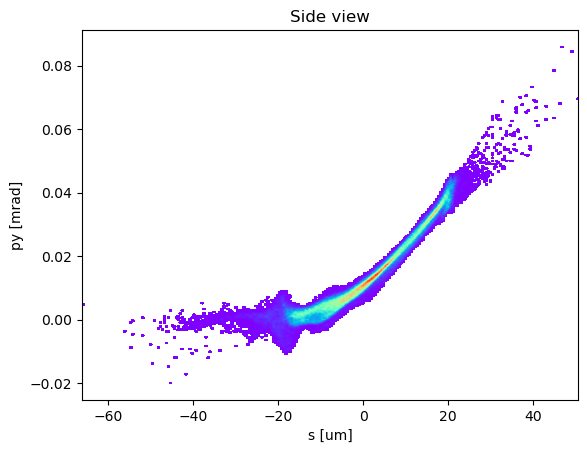This notebook was created by Sergey Tomin (sergey.tomin@desy.de) and Igor Zagorodnov for Workshop: Designing future X-ray FELs. Updated September 2020.
4. Wakefields
- Wake table format
- Wakefields of a Beam near a Single Plate in a Flat Dechirper
- Crosscheck with analytics: Dipole kick
Chirper.
Influence of corrugated structure on the electron beam. This example based on the work: I. Zagorodnov, G. Feng, T. Limberg. Corrugated structure insertion for extending the SASE bandwidth up to 3% at the European XFEL.
Gerometry of the corrugated structure. The blue ellipse represents an electron beam propagating along the z axis.
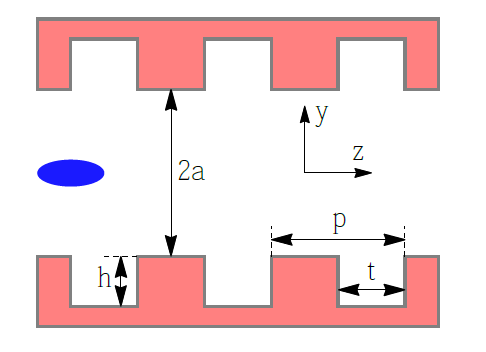
Wakefields
In order to take into account the impact of the wake field on the beam the longitudinal wake function of point charge through the second order Taylor expansion is used. In general case it uses 13 one-dimensional functions to represent the longitudinal component of the wake function for arbitrary sets of the source and the wittness particles near to the reference axis. The wake field impact on the beam is included as series of kicks.
The implementation of the wakefields follows closely the approach described in:
- O. Zagorodnova, T. Limberg, Impedance budget database for the European XFEL, in Proceedings of 2009 Particle Accelerator Conference,(Vancouver, Canada, 2009)
- M. Dohlus, K. Floettmann, C. Henning, Fast particle tracking with wake fields, Report No. DESY 12-012, 2012.
This example will cover the following topics:
- Initialization of the wakes and the places of their applying
- tracking of second order with wakes
Requirements
- beam_chirper.ast - input file, initial beam distribution in ASTRA format (was obtained from s2e simulation performed with ASTRA and CSRtrack).
- wake_vert_1m.txt - wake table of the vertical corrugated structure (was calculated with ECHO)
- wake_hor_1m.txt - wake table of the vertical corrugated structure (was calculated with ECHO)
Wake Table format
We use the same format of the wakes as implemented in ASTRA and the description of the format can be found in M. Dohlus, K. Floettmann, C. Henning, Fast particle tracking with wake fields, Report No. DESY 12-012, 2012.
Second order Taylor expansion of the longitudinal wake () in the transverse coordinates
where and transverse coordinates of the source particle and and are transverse coordinates of the observer, is distance between source and observer. Thus to describe longitudinal wake we need 13 functions .
The transverse components are uniquely related to the longitudinal wake by causality and Panofsky-Wenzel-Theorem.
For each of these coefficients, we use the representation in O. Zagorodnova, T. Limberg, Impedance budget database for the European XFEL
where , are nonsingular functions, which can be tabulated easily, and constants , , and have the meaning of resistivity, inductance, and capacitance, correspondingly. The functions , can be represented by table, e.g. [, ].
Now we can describe whole table how it is saved in a file.
| ... | ... |
| ... | ... |
| ... | ... |
| ... | ... |
In the very first line, is number of functions in the table. After that, a typical table repeated times describing every function.
Every table starts with and which are number of points of and functions. Next two lines are included , , and entry which describes the subscript of the auxiliary function . Next lines described function , and after that next lines described function .
And to describe next we repeat procedure.
The unit is for , for and for all other coefficients.
Import of modules
# the output of plotting commands is displayed inline within frontends,
# directly below the code cell that produced it
%matplotlib inline
# this python library provides generic shallow (copy) and deep copy (deepcopy) operations
from copy import deepcopy
import time
# import from Ocelot main modules and functions
from ocelot import *
# import from Ocelot graphical modules
from ocelot.gui.accelerator import *
# load beam distribution
# this function convert Astra beam distribution to Ocelot format
# - ParticleArray. ParticleArray is designed for tracking.
# in order to work with converters we have to import
# specific module from ocelot.adaptors
from ocelot.adaptors.astra2ocelot import *
Layout of the Corrugated Structure Insertion and Creation of the Ocelot Lattice

Layout of the corrugated structure insertion
In this section, we define the beamline using the MagneticLattice class and compute the Twiss parameters.
Relevant documentation:
D00m25 = Drift(l = 0.25)
D01m = Drift(l = 1)
D02m = Drift(l = 2)
# Create markers for defining places of the wakes applying
w1_start = Marker()
w1_stop = Marker()
w2_start = Marker()
w2_stop = Marker()
w3_start = Marker()
w3_stop = Marker()
w4_start = Marker()
w4_stop = Marker()
w5_start = Marker()
w5_stop = Marker()
w6_start = Marker()
w6_stop = Marker()
# quadrupoles
Q1 = Quadrupole(l = 0.5, k1 = 0.215)
# lattice
lattice = (D01m, w1_start, D02m, w1_stop, w2_start, D02m, w2_stop,
w3_start, D02m, w3_stop, D00m25, Q1, D00m25,
w4_start, D02m, w4_stop, w5_start, D02m, w5_stop,
w6_start, D02m, w6_stop, D01m)
# creation MagneticLattice
lat = MagneticLattice(lattice, method={"global": SecondTM})
# calculate twiss functions with initial twiss parameters
tws0 = Twiss()
tws0.E = 14 # in GeV
tws0.beta_x = 22.5995
tws0.beta_y = 22.5995
tws0.alpha_x = -1.4285
tws0.alpha_y = 1.4285
tws = twiss(lat, tws0, nPoints=None)
# ploting twiss paramentrs.
plot_opt_func(lat, tws, top_plot=["Dx"], fig_name="i1", legend=False)
plt.show()
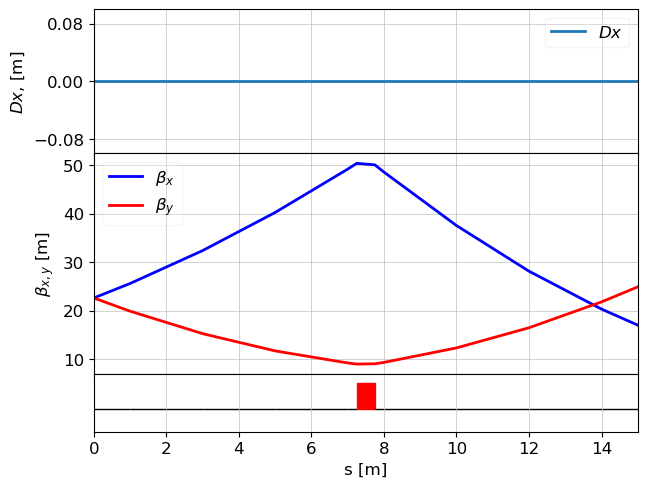
Load beam file
# load and convert ASTRA file to OCELOT beam distribution
# p_array_init = astraBeam2particleArray(filename='beam_chirper.ast')
# save ParticleArray to compresssed numpy array
# save_particle_array("chirper_beam.npz", p_array_init)
p_array_init = load_particle_array("chirper_beam.npz")
plt.plot(-p_array_init.tau()*1000, p_array_init.p(), "r.")
plt.grid(True)
plt.xlabel(r"$\tau$, mm")
plt.ylabel(r"$\frac{\Delta E}{E}$")
plt.show()

Initialization of Wakefields and Their Placement in the Lattice
More details about the Wake class can be found in the documentation:
👉 Wake Class
# load wake tables of corrugated structures
wk_vert = WakeTable('wake_vert_1m.txt')
wk_hor = WakeTable('wake_hor_1m.txt')
# creation of wake object with parameters
wake_v1 = Wake()
# w_sampling - defines the number of the equidistant sampling points for the one-dimensional
# wake coefficients in the Taylor expansion of the 3D wake function.
wake_v1.w_sampling = 500
wake_v1.wake_table = wk_vert
wake_v1.step = 1 # step in Navigator.unit_step, dz = Navigator.unit_step * wake.step [m]
# Alternatively, all parameters can be set directly in the constructor:
wake_h1 = Wake(step=1, w_sampling=500, wake_table=wk_hor)
wake_v2 = deepcopy(wake_v1)
wake_h2 = deepcopy(wake_h1)
wake_v3 = deepcopy(wake_v1)
wake_h3 = deepcopy(wake_h1)
Adding Wakefields to the Lattice
The Navigator class defines the tracking step size (dz) and manages which physics processes are applied at each step.
To include any Physics Process (such as Space Charge, CSR, Wake and so on), you must use:
Method:
Navigator.add_physics_proc(physics_proc, elem1, elem2)
physics_proc: an instance of a physics process (e.g.Wake,SpaceCharge,CSR)elem1,elem2: the first and last lattice elements between which the process will be applied
Step Size Control
You must also define the unit_step in meters (default is 1.0 m):
navi.unit_step = 0.02 # for example, 2 cm step size
Each physics process is applied every step multiples of unit_step:
dz = unit_step x step
- The
stepattribute must be an integer. - This allows you to control how frequently each effect is applied — for example, less frequently at higher energies to reduce computation time.
navi = Navigator(lat)
# add physics proccesses
navi.add_physics_proc(wake_v1, w1_start, w1_stop)
navi.add_physics_proc(wake_h1, w2_start, w2_stop)
navi.add_physics_proc(wake_v2, w3_start, w3_stop)
navi.add_physics_proc(wake_h2, w4_start, w4_stop)
navi.add_physics_proc(wake_v3, w5_start, w5_stop)
navi.add_physics_proc(wake_h3, w6_start, w6_stop)
# definiing unit step in [m]
navi.unit_step = 0.2
# deep copy of the initial beam distribution
p_array = deepcopy(p_array_init)
print("tracking with Wakes .... ")
start = time.time()
tws_track, p_array = track(lat, p_array, navi)
print("\n time exec:", time.time() - start, "sec")
tracking with Wakes ....
z = 15.0 / 15.0. Applied: 5.0. Applied: Wake
time exec: 1.3916778564453125 sec
Longitudinal beam distribution
tau0 = p_array_init.tau()
p0 = p_array_init.p()
tau1 = p_array.tau()
p1 = p_array.p()
plt.figure(1)
plt.plot(-tau0*1000, p0, "r.", -tau1*1000, p1, "b.")
plt.legend(["before", "after"], loc=4)
plt.grid(True)
plt.xlabel(r"$\tau$, mm")
plt.ylabel(r"$\frac{\Delta E}{E}$")
plt.show()
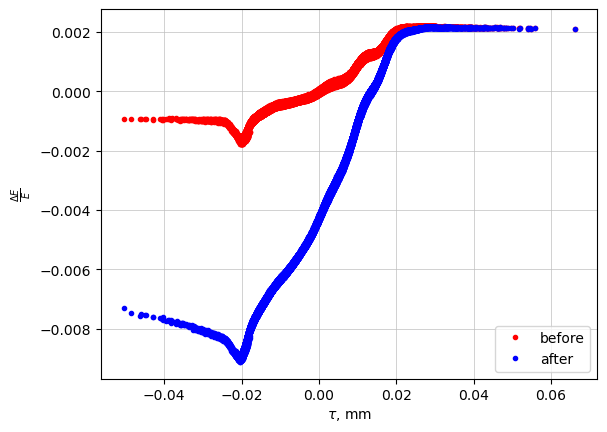
Beam distribution
# by default the beam head on the left side
show_e_beam(p_array, figsize=(8,6))
plt.show()
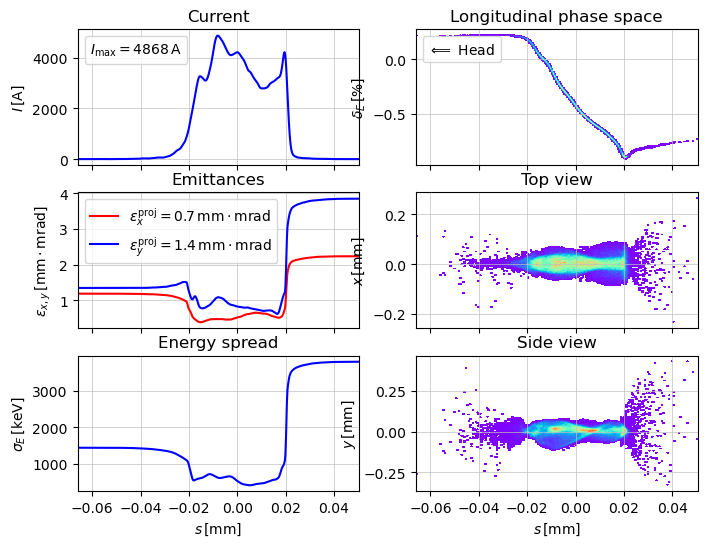
# plotting twiss parameters.
plot_opt_func(lat, tws_track, top_plot=["Dx"], fig_name="i1", legend=False)
plt.show()
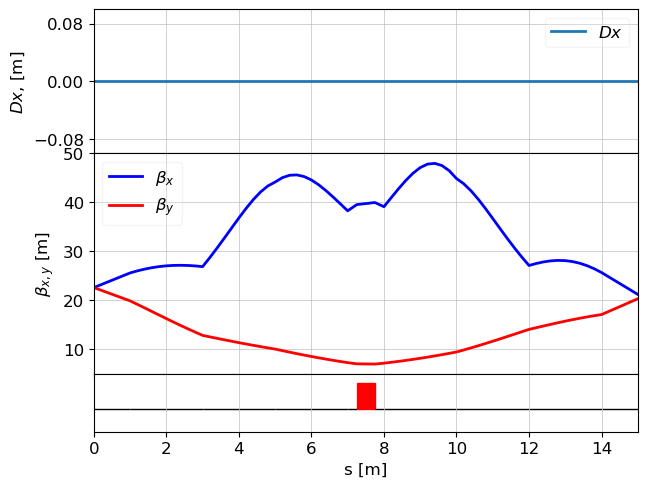
Wakefields of a Beam near a Single Plate in a Flat Dechirper
For some FEL applications, e.g. a two-color scheme, only one flat corrugated structure can be used to get a correlated transverse kick along the electron bunch. In that case, we can use analytical approach from I. Zagorodnov, G. Feng, T. Limberg. Corrugated structure insertion for extending the SASE bandwidth up to 3% at the European XFEL and K. Bane, G. Stupakov, and I. Zagorodnov, Wakefields of a Beam near a Single Plate in a Flat Dechirper to calculate described above the wakefield tables.
Due to the use of assumptions in the analytical approach, a transverse kick is infinite if the electron beam distance to the plate wall is zero.
A small note about transverse modes
Let's look at the wakefield components. Let's start with the expression above:
Expand the result of the multiplication:
Using Panofsky-Wenzel-Theorem the transverse components are:
where monopole transverse component, - dipole component, - quadrupole component,
where - monopole transverse component, - dipole component, - quadrupole component.
Integral forms:
# create a simple lattice MagneticLattice
m1 = Marker()
m2 = Marker()
# quadrupoles
Q1 = Quadrupole(l = 0.5, k1 = 0.215)
lattice = (Drift(l=1), m1, Drift(l=1), m2, Drift(l=2), Q1, Drift(l=2))
lat = MagneticLattice(lattice, method={"global": SecondTM})
Describe corrugated structure and add wake to the lattice
# description of args can be also be shown with Shift+Tab
sigma = np.std(p_array.tau())
print("RMS long beam size: ", sigma * 1e6, " um")
wk_tv_kick = WakeTableDechirperOffAxis(b=500*1e-6, # distance from the plate in [m]
a=0.01, # half gap between plates in [m]
width=0.02, # width of the corrugated structure in [m]
t=0.25*1e-3, # longitudinal gap in [m]
p=0.5*1e-3, # period of corrugation in [m]
length=1, # length of the corrugated structure in [m]
sigma=12e-6, # characteristic (rms) longitudinal beam size in [m]
orient="horz") # "horz" or "vert" plate orientation
# creation of wake object with parameters
wake = Wake()
# w_sampling - defines the number of the equidistant sampling points for the one-dimensional
# wake coefficients in the Taylor expansion of the 3D wake function.
wake.w_sampling = 500
wake.wake_table = wk_tv_kick
wake.step = 1 # step in Navigator.unit_step, dz = Navigator.unit_step * wake.step [m]
navi = Navigator(lat)
# add physics proccesses
navi.add_physics_proc(wake, m1, m2)
RMS long beam size: 12.073257604557314 um
Track the beam through the lattice
# deep copy of the initial beam distribution
p_array = deepcopy(p_array_init)
print("tracking with Wakes .... ")
start = time.time()
tws_track, p_array = track(lat, p_array, navi)
print("\n time exec:", time.time() - start, "sec")
tracking with Wakes ....
z = 6.5 / 6.5. Applied: Wake
time exec: 0.12894392013549805 sec
# by default the beam head on the left side
show_e_beam(p_array, figsize=(8,6))
plt.show()
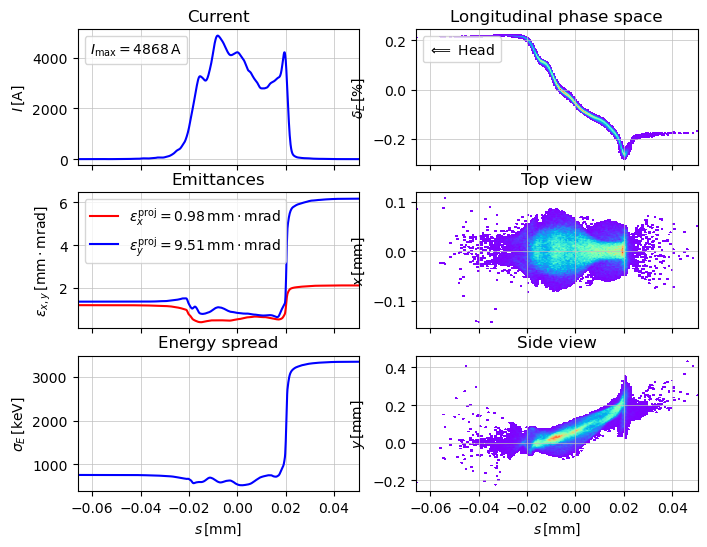
Crosscheck with analytics: Dipole kick
We are going to crosscheck our current implementation with formulas from K. Bane, G. Stupakov, and I. Zagorodnov, Wakefields of a Beam near a Single Plate in a Flat Dechirper:
with
Let's take the same parameters from example above:
Period, p = 0.5 mm
Longitudinal gap, t = 0.25 mm
Distance from the plate, b = 500 m
p = 0.5e-3 # period
t = 0.25e-3 # Longitudinal gap
b = 500e-6 # Distance from the plate
alpha = 1 - 0.465 * np.sqrt(t/p) - 0.07 * t/p
print("alpha = ", alpha)
s0 = 8*b**2 * t / (9 * np.pi * alpha**2 * p**2)
print("s0 = ", s0*1e6, " [um]")
alpha = 0.6361953467482554
s0 = 174.765875517375 [um]
Dipole wake
s = np.linspace(0, 100, num=100) *1e-6
w = lambda s: 2./b**3 * s0 * (1 - (1 + np.sqrt(s/s0)) * np.exp(- np.sqrt(s/s0))) * Z0 * speed_of_light / (4 * np.pi)
MV = 1e6
nC = 1e-9
plt.plot(s*1e6, np.array([w(si) for si in s])*nC/MV )
plt.xlabel("s [um]")
plt.ylabel("Wd [MV/(nC m)]")
plt.show()
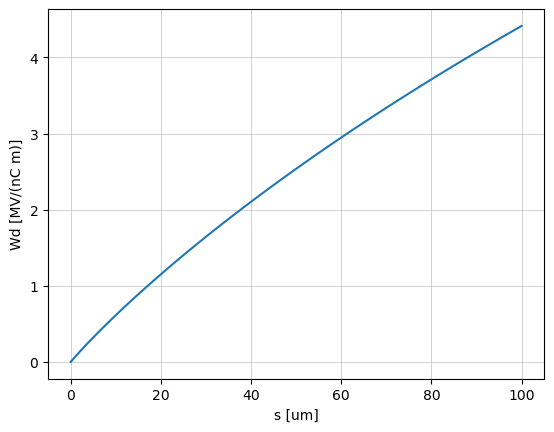
Convolution wake with the beam current
def convolve_beam(current, wake):
"""
convolve wake with beam current
:param current: current[:, 0] - s in [m], current[:, 1] - current in [A]. The beam head is on the left
:param wake: wake function in form: wake(s)
:return: wake_kick[:, 0] - s in [m], wake_kick[:, 1] - V
"""
s_shift = current[0, 0]
current[:, 0] -= s_shift
s = current[:, 0]
step = (s[-1] - s[0]) / (len(s) - 1)
q = current[:, 1] / speed_of_light
w = np.array([wake(si) for si in s])
wake = np.convolve(q, w) * step
s_new = np.cumsum(np.ones(len(wake))) * step
wake_kick = np.vstack((s_new, wake))
return wake_kick.T
I = s_to_cur(p_array.tau(), 0.01 * np.std(p_array.tau()), np.sum(p_array.q_array), speed_of_light)
dipole_kick = convolve_beam(I, w)
fig, ax1 = plt.subplots()
color = 'tab:red'
ax1.set_xlabel('s [mm]')
ax1.set_ylabel('Wake [MV]', color=color)
ax1.plot(dipole_kick[:, 0] * 1e3, dipole_kick[:, 1] * 1e-6, color=color)
ax1.tick_params(axis='y', labelcolor=color)
ax2 = ax1.twinx()
color = 'tab:blue'
ax2.set_ylabel('I [kA]', color=color)
ax2.plot(I[:, 0] * 1e3, I[:, 1] * 1e-3, color=color)
ax2.tick_params(axis='y', labelcolor=color)
plt.show()
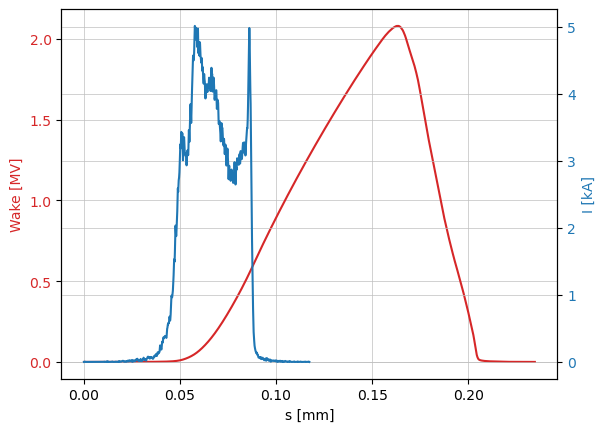
length = 1 # corrugated structure in [m]
p_array = deepcopy(p_array_init)
z = p_array.tau()
ind_z_sort = np.argsort(z)
z_sort = z[ind_z_sort]
wd = np.interp(z_sort - z_sort[0], dipole_kick[:, 0], dipole_kick[:, 1])
delta_E_y = wd * 1e-9 * length
pc_ref = np.sqrt(p_array.E ** 2 / m_e_GeV ** 2 - 1) * m_e_GeV
delta_py = delta_E_y / pc_ref
p_array.rparticles[3][ind_z_sort] += delta_py
show_density(p_array.tau() * 1e3, p_array.py() * 1e3, ax=None, nbins_x=250, nbins_y=250,
interpolation="bilinear", xlabel="s [mm]", ylabel='py [mrad]', nfig=50,
title="Side view", figsize=None, grid=False)
plt.show()
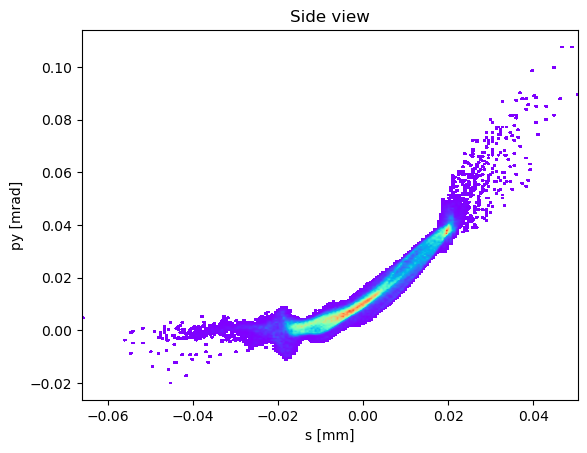
p_array = deepcopy(p_array_init)
wk_tv_kick = WakeTableDechirperOffAxis(b=b, # distance from the plate in [m]
a=0.01, # half gap between plates in [m]
width=0.02, # width of the corrugated structure in [m]
t=t, # longitudinal gap in [m]
p=p, # period of corrugation in [m]
length=1, # length of the corrugated structure in [m]
sigma=12e-6, # characteristic (rms) longitudinal beam size in [m]
orient="horz") # "horz" or "vert" plate orientation
# creation of wake object with parameters
wake = Wake()
# w_sampling - defines the number of the equidistant sampling points for the one-dimensional
# wake coefficients in the Taylor expansion of the 3D wake function.
wake.w_sampling = 500
wake.wake_table = wk_tv_kick
wake.step = 1 # step in Navigator.unit_step, dz = Navigator.unit_step * wake.step [m]
wake.prepare(None)
wake.s_start = 0
wake.s_stop = 1
wake.apply(p_array, dz=1)
show_density(p_array.tau() * 1e6, p_array.py() * 1e3, ax=None, nbins_x=250, nbins_y=250,
interpolation="bilinear", xlabel="s [um]", ylabel='py [mrad]', nfig=60,
title="Side view", figsize=None, grid=False)
plt.show()
